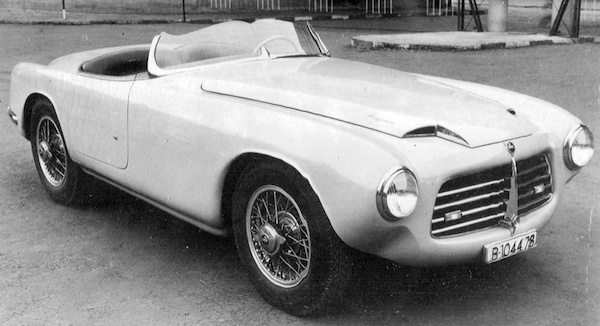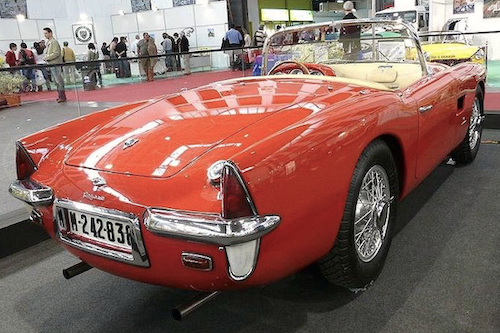Those coachbuilt bodies were mostly furnished by Touring in Italy and Saoutchik in France. A few were by Serra of Pegaso's home town, Barcelona.
Touring and Serra bodies stayed close to basic styles of each firm, whereas Saoutchik bodies were more varied.
1952 Pegaso Z-102 Spider "Tibidabo" by Touring
Early on, Touring established its theme of chopped out hood segments. The same was applied on rear ends of coupes. Note the lack of a front bumper. This was fairly typical of Pegasos, though some had sketchy bumper segments up front.
1953 Pegaso Z-102 "Thrill" showcar by Touring
The front end is typical Touring-Pegaso, but the rest is showcar jazz. Some later American Motors designs had a similar feeling.
1954 Pegaso Z-102 Berlinetta by Touring - RM Sotheby's auction photo
This is a typical Touring body.
1954 Pegaso Z-102 Berlinetta by Touring - unknown photo source
The greenhouse is high, the hood long: another fine Touring design.
Another Sotheby's photo. Note the chopped-out bits at the rear. The window design is logical, but the chrome links aren't really needed.
1952 Pegaso Z-102 Berlinetta by Soutchik
Saoutchik made a few coupés and cabriolets with this fender design. Unusually, there is a substantial front bumper that some later Saoutchik Pegasos lacked.
1954 Pegaso Z-102 Berlinetta by Saoutchik - auction photos
This seems to be a more common Saoutchik design for Pegaso. Note the nearly invisible bumper.
The fenderline is thrusting and the greenhouse is small.
A more squared-off trunk lid blended with the fenders might have been more practical and better looking.
1954 Pegaso Z102 Cabriolet by Saoutchik - RM Sotheby's photos
The lower body design is the same as that of the car in the previous images.
Rear bumpers offer no serious protection. This car should never be parked on a Paris street.
1955 Pegaso Z-103 Spider by Serra - unknown source
A nice, clean design. Unlike most Pegasos, this car and the one below had panoramic (wraparound) windshields: very mid-1950s.
1956 Pegaso Z-102 Spider by Serra - unknown source
This car has a fairly serious rear bumper. I like this rear design better than Saoutchhik's. It's bold, but logical. Note the vent on the front fender that's absent in the car in the previous photo.





















































